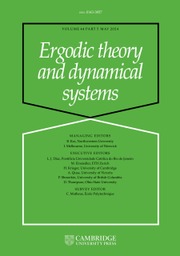No CrossRef data available.
Article contents
Ergodic optimization for continuous functions on non-Markov shifts
Published online by Cambridge University Press: 15 August 2025
Abstract
Ergodic optimization aims to describe dynamically invariant probability measures that maximize the integral of a given function. For a wide class of intrinsically ergodic subshifts over a finite alphabet, we show that the space of continuous functions on the shift space contains two disjoint subsets: one is a dense  $G_\delta $ set for which all maximizing measures have ‘relatively small’ entropy; the other is the set of functions having uncountably many, fully supported ergodic maximizing measures with ‘relatively large’ entropy. This result generalizes and unifies the results of Morris [Discrete Contin. Dyn. Syst. 27 (2010), 383–388] and Shinoda [Nonlinearity 31 (2018), 2192–2200] on symbolic dynamics, and applies to a wide class of intrinsically ergodic non-Markov symbolic dynamics without the Bowen specification property, including any transitive piecewise monotonic interval map, some coded shifts, and multidimensional
$G_\delta $ set for which all maximizing measures have ‘relatively small’ entropy; the other is the set of functions having uncountably many, fully supported ergodic maximizing measures with ‘relatively large’ entropy. This result generalizes and unifies the results of Morris [Discrete Contin. Dyn. Syst. 27 (2010), 383–388] and Shinoda [Nonlinearity 31 (2018), 2192–2200] on symbolic dynamics, and applies to a wide class of intrinsically ergodic non-Markov symbolic dynamics without the Bowen specification property, including any transitive piecewise monotonic interval map, some coded shifts, and multidimensional  $\beta $-transformations. Along with these examples of application, we provide an example of an intrinsically ergodic subshift with positive obstruction entropy to specification.
$\beta $-transformations. Along with these examples of application, we provide an example of an intrinsically ergodic subshift with positive obstruction entropy to specification.
MSC classification
Information
- Type
- Original Article
- Information
- Copyright
- © The Author(s), 2025. Published by Cambridge University Press


